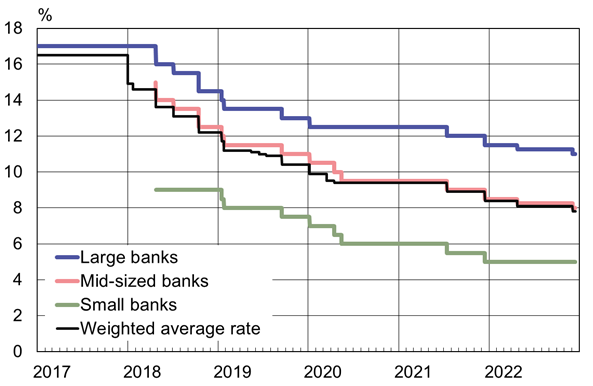BOFIT Weekly Review 48/2022
China’s central bank lowers reserve requirement for commercial banks
Following State Council comments chaired by Premier Li Keqiang a couple of days earlier, the People’s Bank of China last week announced it would lower the reserve requirement ratio (RRR). Effective December 5, the general reserve requirement for commercial banks will fall by 25 basis point for large and mid-sized banks. Smallest banks are already at the lowest RRR bound of 5 %. The RRR will drop to 11 % for large banks and to 8 % for mid-sized banks. The RRR for individual banks can deviate from the general level and a large share of banks are entitled to some sort of reduction in their RRR. According to the PBoC, the weighted average RRR in the banking sector after including these exceptions will fall to 7.8 %.
The PBoC justified the RRR cut as providing support to the real economy and increasing liquidity in the financial system. The tiny rate cut in itself is not expected to have perceptible impact on the economy and China’s financial markets are hardly lacking in liquidity at the moment. For example, interbank market rates are lower than PBoC policy rates. The current problem is largely a lack of demand for financing. The growth in the stock of household loans has slowed considerably this year, growing at just 3.6 % y-o-y in October. Housing loans constitute the bulk of household borrowing. The total stock of bank loans grew by just under 11 % y-o-y in October. Officials last month encouraged banks to continue supporting small firms affected by the covid pandemic through deferring interest and loan payments. The PBoC noted that reducing the reserve requirement helps the banking sector also in this task.
The People’s Bank of China slightly cut its general reserve requirement ratio for banks for the second time this year.
Sources: People’s Bank of China, CEIC and BOFIT.